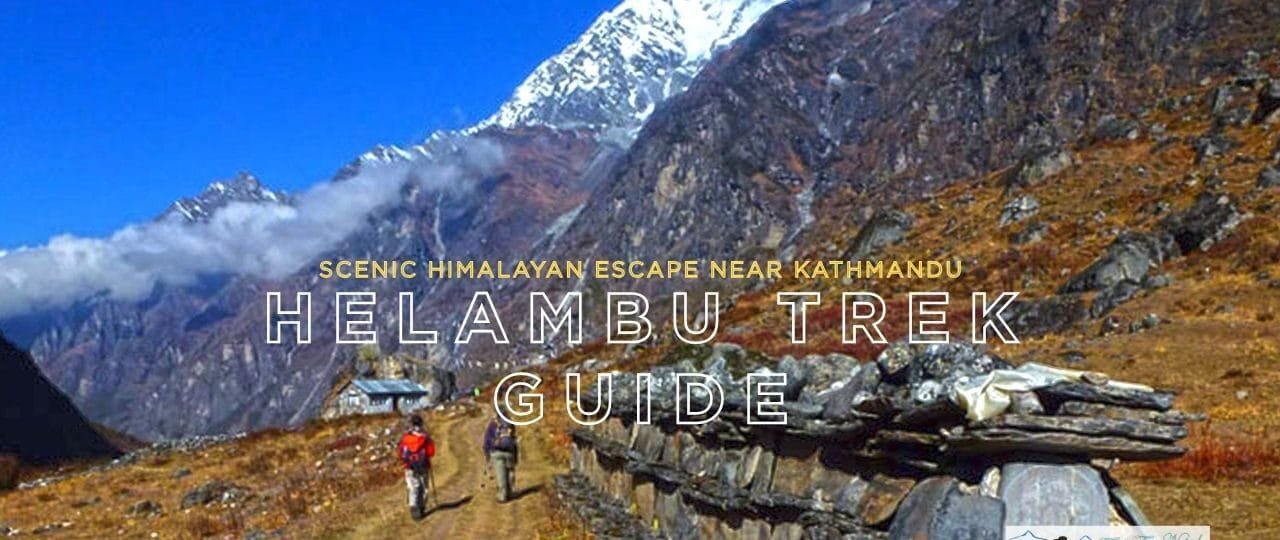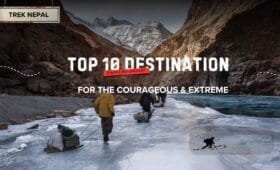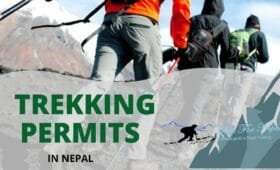The Helambu Trek might be your ideal match if you’re seeking a tranquil Himalayan route close to Kathmandu. Known for its cultural immersion, moderate altitudes, and mesmerizing landscapes, the Helambu Trek itinerary spans lush forests, terraced fields, and Tamang or Sherpa villages brimming with Tibetan-influenced traditions. Despite being just a short drive from the bustling capital, Helambu remains uncrowded, offering solitude to trekkers who crave an authentic Nepali experience without traveling far from city comforts.
In this comprehensive Helambu Trek guide, we’ll explore every aspect of the Trek—from typical costs and route complexities to accommodations, altitude, best times to visit, and tips for integrating volunteering with local communities. You’ll also discover essential information like the Helambu Trek Map, recommended gear, cultural insights, permit requirements, and guidance on selecting the right Helambu Trek Package. Whether you’re a beginner hiker eager for your first multi-day trek or an experienced traveler seeking a relaxing mini-expedition, this article has you covered. Let’s dive into the serene trails, welcoming hosts, and breathtaking vistas that characterize the Helambu Trek.
Introduction
1. Introduction: Why the Helambu Trek?
Despite being just an hour’s drive from Kathmandu, the Helambu Trek immerses you in a serene Himalayan realm. The region’s name, “Helambu,” likely originates from the Hyolmo people, an indigenous group that weaves centuries-old beliefs with Buddhist customs. If your schedule is tight or you prefer a mellow route with moderate ascents, Helambu is an excellent choice. Some select it as an acclimatization trek before tackling larger routes like the Annapurna Circuit or Everest Base Camp.
Statistic: According to the Nepal Tourism Board, fewer than 10% of trekkers do Helambu annually, which is overshadowed by more famous routes. This limited footfall spares Helambu from mass tourism in other areas. As a result, you’ll find quiet teahouses, undisturbed trails, and a personal connection with local families. Meanwhile, the vantage points reveal peaks like Langtang Lirung and Dorje Lakpa in the distance.
Quote:
“After a frantic pace in Kathmandu, I found Helambu unbelievably calm. Each day offered new cultural encounters, from Buddhist monasteries to Tamang villages, in just a short trek,” says Mark, an Australian teacher who recently completed the route.
2. Historical & Cultural Overview
Bordering the Langtang region, Helambu hosts a cultural mix: in mid-altitude zones, you meet Tamang and Hyolmo communities deeply influenced by Tibetan Buddhism. Sherpa traditions also appear in the higher settlements. The area’s synergy of farmland, spiritual shrines, and forest sanctuaries fosters a unique tapestry.
Pre-1980s, the region was a lesser-known corner for trekking, overshadowed by Everest or Annapurna hype. However, Helambu gained traction as more travelers sought peaceful routes near Kathmandu. Many visitors love its immediate cultural immersion: within a single day, you transition from busy roads near Sundarijal or Melamchi to quiet trails flanked by terrace farming and pine groves. This blend of proximity and authenticity cements Helambu as a top pick for short Himalayan treks.
Itinerary
3. Key Highlights of Helambu Trek Itinerary
A typical Helambu Trek Itinerary spans 5–8 days, though some complete it in 4 days if pressed for time. Below is a common framework:
- Day 1: Kathmandu → Sundarijal → Chisapani (2,150m)
A short ride from Kathmandu leads to Sundarijal (1,350m). You climb through Shivapuri National Park’s dense forests. By late afternoon, you reach Chisapani, which offers sweeping views of the Himalayas if the weather cooperates. - Day 2: Chisapani → Kutumsang (~2,470m)
Trails meander across ridges, farmland, and small hamlets. Some sections can be steep, but you’re rewarded with glimpses of Langtang peaks. - Day 3: Kutumsang → Thadepati (3,600m)
The route ascends steadily, merging rhododendron clusters with open vistas. Thadepati is a vantage point for Ganesh Himal, Dorje Lakpa, and Gaurishankar (on clear days). - Day 4: Thadepati → Tarke Gyang (2,590m)
Descend into Helambu’s core, encountering Sherpa or Hyolmo villages. Tarke Gyang is the region’s “cultural capital,” boasting old monasteries and vibrant local life. - Day 5: Tarke Gyang → Sermathang (2,610m)
A mellower route among terraced fields, apple orchards, and quiet forests. Sermathang is a scenic resting place with modest teahouses. - Day 6: Sermathang → Melamchi Bazaar → Kathmandu
A final walk downhill to Melamchi (~800m), where buses or jeeps return you to Kathmandu in ~3–4 hours.
You might adapt the itinerary, for instance, skipping the Chisapani start or adding an extra day in Tarke Gyang. The Helambu Trek Duration remains flexible. Some link Helambu with Langtang or Gosaikunda for a longer circuit.
4. Understanding the Helambu Trek Difficulty
The Helambu Trek Difficulty is moderate, with daily ascents of ~500–800 meters. Altitudes rarely exceed ~3,600m at Thadepati Pass, so altitude sickness risk is less than on routes like Everest Base Camp or Manaslu. Trails can be muddy or slippery after rain, especially around Chisapani or Tarke Gyang. However, contained teahouses and shorter distances make it feasible for novices or families wanting to experience trekking.
Fitness:
- Essential cardio (running or cycling) for ~4 weeks suffices.
- Some hillside or stair climbing builds leg strength for daily ascents.
- Gentle, steady pacing ensures you adapt well, especially if you are new to Himalayan heights.
5. Mapping Your Route: A Look at the Helambu Trek Map
A reliable Helambu Trek Map typically highlights:
- Sundarijal: Common start, perched at 1,350m, near Kathmandu Valley’s outskirts.
- Shivapuri National Park: Early day crossing featuring waterfalls and forest glades.
- Chisapani: A vantage point at ~2,150m for sunrise glimpses of Ganesh Himal or Langtang Lirung.
- Kutumsang, Thadepati: Mid-altitude ridges, bridging entry into Helambu’s core.
- Tarke Gyang, Sermathang: Cultural hotspots where local families host teahouses.
- Melamchi Bazaar: Endpoint for a bus or jeep back to Kathmandu.
Some prefer the reverse route, starting from Melamchi or merging Helambu with Gosaikunda via Lauribina Pass. Verifying with local guides or the TIMS office for post-monsoon landslides or trail modifications is crucial.
Costing
6. How Much Does It Cost? Explaining the Helambu Trek Cost
The Helambu Trek Cost is moderate, partly due to simpler logistics:
- Permits:
- Shivapuri National Park entry (~USD 10).
- TIMS card (~USD 10–20 if independent, ~USD 10 if via an agency).
- Transport:
- Kathmandu → Sundarijal by taxi or bus: ~USD 2–10.
- Return from Melamchi Bazaar by bus: ~USD 2–3.
- Food & Lodging:
- Teahouse rooms: ~USD 3–5 per night.
- Daily meals: ~USD 15–20 for three simple meals + hot drinks.
- Guide / Porter (Optional):
- ~USD 25–30/day for a guide, porters ~USD 15–25/day.
A typical 6-day itinerary might cost ~USD 150–300 if you go solo (excluding gear). If you prefer a Helambu Trek Package with an agency covering all the basics, budget ~USD 400–600, depending on your comfort level.
7. Booking the Right Helambu Trek Package
Some travelers prefer a self-managed approach, but a Helambu Trek Package offers:
- Guided security: Although altitudes are moderate, Helambu Trek guides ensure route clarity and cultural insights.
- Lodging & Meals: Guaranteed teahouse reservations in high season.
- Transportation: Buses or private jeeps arranged, plus possible side tours to Helambu monasteries.
- Simplicity: Freed from permit runs or lodging hunts, focusing on trek enjoyment.
Group tours cost less but are less flexible. Private tours cater to customized pacing or side trip expansions. If volunteering with a local village intrigues you, some packages integrate short service projects into the route.
8. Securing Helambu Trek Permits
Helambu Trek Permits differ by route, but typically:
- TIMS (Trekkers’ Information Management System):
- ~USD 10 if arranged via a licensed agency or ~USD 20 if independent.
- Shivapuri National Park Entry:
- ~USD 10. If crossing alternative boundaries, confirm local municipality fees.
The LNTP entry permit (~USD 30) might apply in some variations that pass through Langtang National Park. Always check your chosen route or itinerary’s coverage. Carry your passport, visa, and passport-size photos.
9. Helambu Trek Best Time: Seasons & Weather
Helambu Trek Weather typically feels milder than high-altitude circuits. The route rarely tops 3,600m, meaning a shorter window for freezing conditions. The Helambu Trek Best Time is usually:
- Autumn (Sept–Nov): Crisp skies, moderate temps ~15–20°C. Harvest vibes in farmland, busier teahouses.
- Spring (Mar-May): Vibrant blooms, occasionally hazy afternoons, comfortable days.
- Winter (Dec–Feb): Sub-zero nights at Thadepati or higher, fewer trekkers, clear mornings. Some teahouses reduce services.
- Monsoon (Jun–Aug): Daily rains, muddy trails, potential leeches or landslides. Fewer crowds but less scenic clarity.
10. Hiring a Helambu Trek Guide
Though not mandatory, a Helambu Trek Guide enriches your journey:
- Route Advice: Minimizes confusion at any cross-trail near Sundarijal or Tarke Gyang.
- Cultural Context: They can interpret local festivals, spiritual shrines, or farmland practices.
- Safety: If unexpected weather or altitude issues arise, Helambu Trek guides coordinate solutions quickly.
A guide costs ~USD 25–30/day plus tips. Given the region’s moderate altitudes, some skip a guide, but novices or culturally curious travelers find them beneficial.
Tips
11. Preparation & Tips for Success
11.1 Physical Training
- Cardio: Running or brisk walks 3–4 times a week for a month.
- Leg Strength: Weighted squats or climbing stairs to adapt to daily ascents.
- Backpack Practice: If carrying your gear, practice day hikes with ~8–10 kg.
11.2 Gear & Clothing
- Layers: Short-sleeve T-shirts plus mid-layer fleece and windproof jacket.
- Footwear: Comfortable trekking boots, well broken in.
- Extras: Refillable water bottle, purifier tablets, a small first-aid kit, and optional trekking poles.
11.3 Acclimatization & Safety
Even though the Helambu Trek Altitude rarely exceeds 3,600m, mild altitude sickness can appear. Pace yourself, drink ~3 liters of water daily, and rest if headaches or nausea hit. The route is generally safe, but monsoon landslide risk or winter snowfall requires caution.
Testimonial
12. Stories from the Trail: Testimonials & Inspiration
Catherine’s Journey
Catherine, a 33-year-old from the US, shares: “I had only eight days in Nepal, so the Helambu Trek felt perfect—close to Kathmandu, culturally rich, but not too strenuous. My highlight was Thadepati’s sunrise, painting the Himalayas gold while local families offered me homemade tea. It felt like a hidden world close to a capital city.”
Community Wins
Villagers often mention how trekkers’ presence fosters local education and improved teahouse infrastructure. Tsering, who runs a lodge near Tarke Gyang, says: “Each trekker’s meal or night’s stay helps us invest in safer footpaths or school materials for our children. We love that Helambu remains calmer than popular routes yet sees enough trekkers to energize our economy.”
FAQs
13. Seven Most Frequently Asked Questions
What is the usual Helambu Trek Duration?
Typically, it takes 5–8 days, though some do a 4-day version or extend to ~10 days if linking with Gosaikunda or Langtang.
How difficult is the Helambu Trek Difficulty?
Moderately easy to moderate. Ascents rarely top 3,600m. Ideal for novices seeking a Himalayan foothill experience.
What about the Helambu Trek Cost?
If independent, budget ~USD 150–300 for 5–6 days, covering permits, teahouse, and food. A Helambu Trek Package might be ~USD 300–500 with a guide, lodging, and transport.
Which Helambu Trek Permits do I need?
TIMS (~USD 10–20) plus a Shivapuri National Park fee (~USD 10). If crossing Langtang National Park sections, you need LNTP entry (~USD 30).
Is a Helambu Trek Guide mandatory?
It is not mandatory, but it is recommended for route clarity, cultural insights, and safety. It costs ~USD 25–30/day.
When is the Helambu Trek Best Time?
Autumn (Sept–Nov) or spring (March) is best for stable weather and clear views. Winter is quieter but colder; the monsoon brings rain and fewer visitors.
How does it compare to other treks near Kathmandu?
Helambu is quieter, more culturally immersive, and has a slightly higher altitude than short routes like Nagarkot. It’s an easy getaway for a 5–—to 8-day scenic trek.
Conclusion
From the vantage of Chisapani’s sunrise to Tarke Gyang’s spiritual calm, the Helambu Trek delivers a scenic, culturally vibrant journey close to Kathmandu. Its moderate altitudes, friendly teahouses, and fewer crowds attract travelers craving authenticity over spectacle. If you’re short on time yet desire an immersion in Himalayan life, this route stands tall among mid-range treks.
Make a Meaningful Impact With ViN
At Volunteers Initiative Nepal (ViN), we invite you to enrich your trekking adventure with service. By pairing your Helambu Trek with volunteering or donation efforts, you magnify the community benefit:
- Volunteer: Donate a day teaching English at a local school near Tarke Gyang or assist in a sustainable farming project.
- Intern: Engage in health or environmental research that addresses local challenges, bridging your academic aims with real-world solutions.
- Donate: Support grassroots initiatives focusing on education, healthcare, or cultural preservation in Helambu’s villages.
- Share: Inspire fellow trekkers to combine mountain exploration with philanthropic acts, forging synergy between tourism and community betterment.
Namaste, and let’s champion a future where trekking fosters personal triumph and communal upliftment. The Helambu Trek awaits scenic ridges, time-honored traditions, and the promise of forging deeper connections with Nepal’s rich heritage.
Info & Tips
Additional Info & Practical Tips
While we’ve covered the fundamentals of Helambu Trek, specific nuances may further enhance your readiness. Below are extra pointers on route variations, cultural courtesy, gear details, and synergy with philanthropic projects.
1. Seasonal Weather & Variations
1.1 Autumn
Crisp mornings and minimal rainfall. Days ~15–20°C below 2,500m, nights ~5–10°C. Perfect for consistent Himalayan vistas.
1.2 Spring
Warmer forest floors, blossoming rhododendrons. Potential haze in afternoons. Temperatures remain moderate.
1.3 Winter
Crisp morning views, fewer trekkers. However, nights can be sub-zero above 3,000m, so pack a warm sleeping bag (comfort ~ -5°C).
1.4 Monsoon
Lush farmland, daily showers, potential leeches below ~2,000m. There is a risk of landslides near roads, so schedule buffer days.
2. Variation: Extended Helambu-Langtang Crossover
Ambitious hikers sometimes merge Helambu with Gosaikunda or Langtang. This ~12–14-day loop crosses Lauribina Pass (~4,610m). If you relish higher altitudes, it’s a grand approach to linking the region’s scenic lakes with Helambu’s cultural tapestry. However, this demands extra gear and higher-level fitness.
3. Cultural Immersion & Etiquette
- Respectful Attire: Short shorts or sleeveless tops might be frowned upon. Keep attire modest near villages or monasteries.
- Language: Learning a few Nepali phrases, like “Namaste” (hello) or “Dhanyabaad” (thank you), fosters warmth.
- Homegrown Crafts: Some villages produce woven items or local produce. Buying these supports families directly.
4. Helambu Trek Safety & Precautions
4.1 Water Purification
Carry purifier drops/tablets or buy boiled water at teahouses for ~USD 1–2/liter. Minimizes plastic bottle waste.
4.2 Physical Concerns
Even if the Helambu route is moderate, muscle cramps or mild altitude discomfort can occur at Thadepati: gentle pacing, hydration, and rest help.
5. Helambu Trek Accommodation & Lodging
5.1 Teahouse Basics
Often run by local families. Rooms typically have twin beds, thick blankets, and a communal dining hall with a wood stove. Menus revolve around dal bhat, noodles, momos, chapati, and tea/coffee.
5.2 Peak Season Bookings
In autumn, teahouses at Chisapani or Tarke Gyang fill quickly on high-traffic weekends. Arrive earlier to secure rooms. Alternatively, a Helambu Trek Package might pre-book lodging.
6. Volunteering with ViN En Route
6.1 Project Types
- Education: If you have teaching experience, help local children with English or extracurricular lessons.
- Environmental: Organize community-based garbage clean-ups or tree-planting in deforested patches.
- Cultural: Document local oral histories or folk songs to preserve intangible heritage.
6.2 Logistics
Coordinate with ViN weeks prior. They can align your trek dates with a short volunteer project, ensuring you have community acceptance and a translator if needed.
7. Trekking Comparisons
7.1 Helambu vs. Langtang
Langtang is further north and features higher altitudes (~4,000m+) and glaciers. Helambu is lower, shorter, and more farmland-forested than glacial. Many novices find Helambu less demanding.
7.2 Helambu vs. Nagarkot
Nagarkot is a day’s vantage point near Kathmandu for sunrise or short day hikes. Helambu is a multi-day expedition that immerses you deeper in village life and culture.
8. Potential Challenges & Solutions
- Language Barrier: Many teahouse owners speak limited English, but the younger general or guides help with transliterations.
- Connectivity: Intermittent phone signal. Don’t rely on stable Wi-Fi.
- Weather Surprises: Afternoon spring storms or sudden winter cold waves. Pack a windproof jacket and quick-drying layers.
9. Sustainability & Responsible Trekking
9.1 Garbage Management
Carry a personal trash bag, ensuring wrappers or plastic are returned to Kathmandu for disposal. Local disposal systems remain limited.
9.2 Economic Impact
Support local produce or handicrafts. This fosters communal prosperity without overshadowing traditions. Tipping guides or porters also acknowledge their labor.




